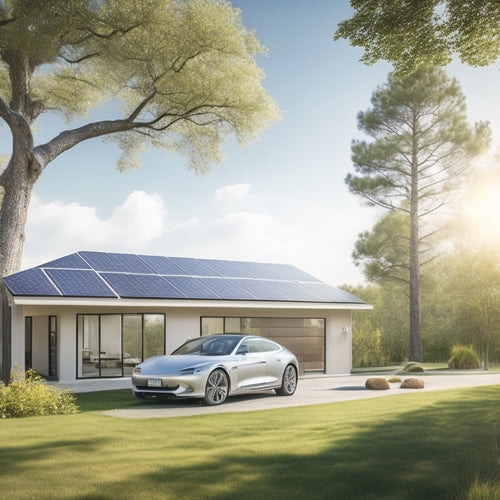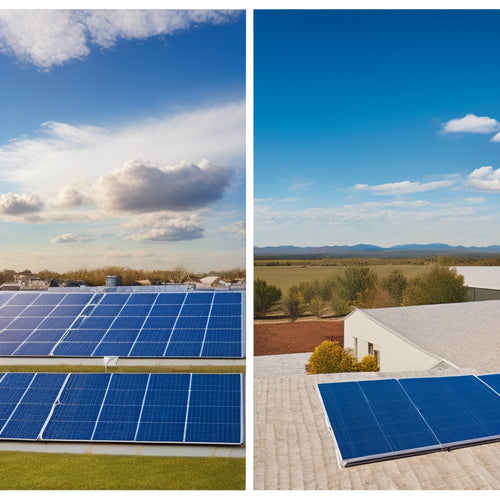
3 Essential Steps for Solar Electricity Installation
Share
To guarantee a successful solar electricity installation, you'll need to follow three essential steps. First, assess your energy needs by analyzing your daily usage, reviewing past utility bills, and evaluating your solar potential. Next, choose the right equipment for your project, selecting suitable solar panels, inverters, and other components that meet your energy requirements. Finally, focus on proper installation and connection, preparing the site, connecting panels to the mounting system, and adhering to local building codes and regulations. By following these steps, you'll be well on your way to utilizing renewable energy - and there's more to learn about optimizing your system for maximum efficiency.
Key Takeaways
- Conduct an energy consumption analysis to identify average daily usage and assess solar energy capture capabilities.
- Select suitable solar panel type, inverter, and equipment that meet energy needs and ensure efficient installation.
- Ensure proper site preparation, connect solar panels to mounting system, and install inverter according to specifications.
- Facilitate easy maintenance and cleaning during panel connection and adhere to local building codes and regulations.
- Test the system for proper functioning and consider consulting with a solar expert for accurate assessment and installation.
Assessing Your Energy Needs
To determine the ideal solar electricity installation for your property, you need to evaluate your energy needs accurately. This involves conducting an energy consumption analysis to identify your average daily energy usage.
Review your past utility bills to calculate your total energy consumption in kilowatt-hours (kWh). Consider factors like appliance efficiency, insulation, and lighting to get an accurate representation of your energy requirements.
Next, perform a solar potential evaluation to determine how much solar energy your property can capture. This involves evaluating your location's solar irradiance, shading patterns, and roof size.
You can use online tools or consult with a solar expert to determine your property's solar potential. By combining your energy consumption analysis with your solar potential evaluation, you'll be able to determine the ideal size and configuration of your solar electricity installation.
This significant step guarantees that your system meets your energy needs efficiently and effectively.
Choosing the Right Equipment
Your solar electricity installation's success depends on selecting the right equipment, which involves evaluating various components, including solar panels, inverters, mounting systems, and monitoring devices.
When it comes to solar panels, you'll need to decide on the type that best suits your needs. Monocrystalline, polycrystalline, and thin-film solar panels are the most common options, each with their own advantages and disadvantages. Monocrystalline panels are the most efficient, while polycrystalline panels offer a more affordable option. Thin-film panels are ideal for small-scale installations.
Inverter options are also essential, as they convert DC power from the solar panels to AC power for your home. You can choose from string inverters, microinverters, or power optimizers. String inverters are the most common, while microinverters provide more flexibility and monitoring capabilities. Power optimizers offer a balance between the two.
When selecting an inverter, consider factors such as efficiency, reliability, and compatibility with your solar panel system. By choosing the right equipment, you'll guarantee an efficient and reliable solar electricity installation that meets your energy needs.
Installation and Connection
As you prepare to install your solar electricity system, confirming a proper connection of all components is vital to guarantee a safe and efficient energy production.
You'll need to verify that the site preparation is done correctly, including clearing the area of debris and confirming the surface is level and secure.
Next, you'll need to connect the solar panels to the mounting system, following the manufacturer's instructions and local regulations.
Make sure to connect the panels in a way that allows for easy maintenance and cleaning.
The inverter, which converts DC power to AC, should be installed according to the manufacturer's specifications and connected to the grid tie.
You'll also need to connect the system to the electrical panel, making certain that it's done safely and efficiently.
It's essential to follow local building codes and regulations during the installation process.
Remember to test the system to verify it's functioning correctly and producing energy efficiently.
Frequently Asked Questions
What Are the Benefits of Solar Electricity Over Traditional Energy Sources?
You're likely familiar with the iconic 'unsinkable' Titanic, but did you know it was powered by coal? Switching to solar electricity can be your lifeboat, offering significant cost savings and a reduced environmental impact - a win-win for your wallet and the planet!
Can I Install Solar Panels on a Rented Property?
You'll need to obtain your landlord's explicit permissions and review your rental agreements before installing solar panels on a rented property, ensuring you understand any restrictions or responsibilities that come with utilizing solar power.
How Long Does a Solar Electricity Installation Warranty Typically Last?
You'll be utilizing solar power for years to come, with a typical warranty lasting 25 years or more, covering 80% of the system's original power output; your installation expectations are secured with extensive warranty coverage, ensuring a reliable energy supply.
Are Solar Panels Resistant to Extreme Weather Conditions?
You'll be pleased to know that solar panels are designed to withstand harsh weather conditions, boasting storm durability and temperature resilience, with most panels rated to operate within -40°C to 85°C, ensuring your power supply remains stable even in extreme climates.
Can I Sell Excess Energy Generated Back to the Grid?
Imagine utilizing the sun's limitless power, and then some! You can sell excess energy back to the grid through net metering, earning energy credits that offset your bills, and even generate revenue, putting you in control of your energy future.
Related Posts
-

Why Invest in Solar Car Battery Chargers Online?
By investing in a solar car battery charger online, you're not only reducing your reliance on fossil fuels but also o...
-

What Role Do Unicycles Play in Urban Transport?
As you navigate through congested city streets, unicycles emerge as a viable solution, slashing carbon emissions by u...
-

Tracking Solar Panels Vs Fixed Panels Cost Savings
When considering solar panel options, you'll want to weigh the cost savings of tracking solar panels versus fixed pan...


